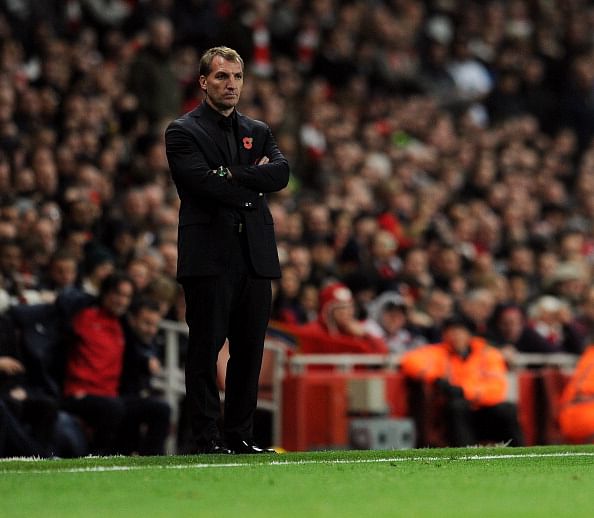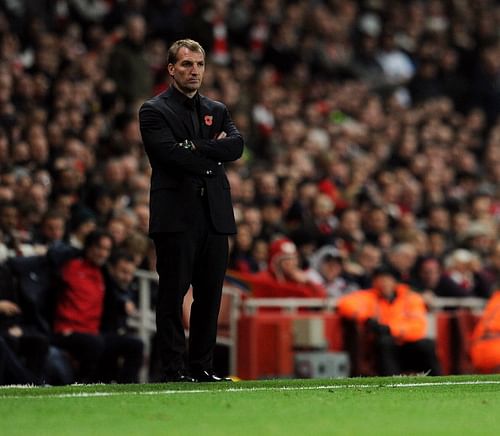
Brendan Rodgers is brilliantly reactive - but now he must keep improvizing

While Daniel Sturridge has been a constant fixture in Liverpool’s first XI since January, the dilemma over whom to play around him is a recurring headache for Brendan Rodgers. It is one that he probably won’t mind, given that last year he was relying on Luis Suarez and two teenagers to carry the attack, but it is nonetheless problematic; what complicates things is that the Merseysiders now play around their strikers to the point of over-reliance.
While Rodgers is a competent manager, he is reactive rather than proactive. When Suarez was banned for biting Branislav Ivanovic, Rodgers fielded Sturridge as the sole number 9 and deployed Philippe Coutinho behind him as a number 10. The pair hit it off instantly: while the Brazilian specializes in unlocking defences with through-balls, Sturridge excels at using his pace and power to beat the last man. In their 9 matches together, Liverpool won 7 times and drew twice, the highlight being a 6-0 demolition of Newcastle where the pair combined to score twice.
But then Coutinho picked up an injury against Swansea, and Suarez returned a match later – presenting Rodgers with yet another tactical dilemma: how to deploy two forwards who both like a free role around the box but are hesitant to drop too deep? Again, the solution lay in common sense and resource optimization. Liverpool have a surfeit of defenders (8 centre-backs when Sebastien Coates returns from injury), and two wing-backs in Glen Johnson and Jose Enrique who like to bomb up the flanks. The obvious answer lay in playing them all in a counter-attacking 3-5-2.
It was used for the first time in a Capital One Cup tie away at Old Trafford and later at Sunderland, where Sturridge and Suarez scored three goals between them, with the former assisting the latter twice. It seemed Rodgers had finally hit on a magic formula. He could play both his forwards in their preferred positions without upsetting the balance of the team. Significantly, this was the first time in over a decade that a Liverpool formation was successfully designed around a strike partnership.
Even with Liverpool’s success, their tactics have come in for some criticism from fans and it is not hard to see why: their 3-man midfield – with a defensive midfielder, a runner and a declining box-to-box attacker – is some distance from providing the creative, entertaining spectacle their supporters want to see. It also makes them over-reliant on their front two. To be fair the 3-5-2 is new to the Premier League, and unusual even in Europe. The best example of a team that has successfully used the formation on a regular basis is Juventus, and it was hardly Antonio Conte’s first choice. He started off with a 3-3-4, but when Arturo Vidal and Andrea Pirlo arrived in the summer of 2011, Conte realised he had an excellent midfield trio (together with Marchisio) and three first-rate centre-backs. Rodgers’ own 3-5-2 evolved out of necessity as well.
Nevertheless, a successful team cannot be a one-trick pony, and Liverpool’s performance at the Emirates on Saturday was ample proof. Arsenal‘s strategy was two-pronged: to pack the midfield and to leave three men at the back against SAS. This strategy served to a. maximize their natural advantage in the centre of the park, and b. negate Liverpool’s most dangerous weapons. Essentially, one team played to its game plan while the other didn’t – Suarez and Sturridge shot wastefully and their dribbling was ineffective (partly due to an inspired display by Laurent Koscielny).
Coutinho’s return gives Rodgers some breathing space, although this may result in another formation switch. Playing the Brazilian behind the two strikers is one solution, but that would necessitate dropping either Henderson or Gerrard. The latter is perhaps the player to drop – at least for a couple of games. Gerrard no longer has the legs or the attacking nous to be a consistent attacking midfielder, which makes Liverpool vulnerable when either forward has an off day. Glen Johnson, arguably the team’s most important functional player for the attacking width and pace he provides down the flanks, is down with fever, and his two understudies – Flanagan and Kelly – are nowhere near experienced enough to carry one side of the team on their own.
All this may well force Rodgers to revert to a 4-4-2 or a 4-3-3 to protect his defenders while harnessing the attacking gifts his strikers possess. With four big matches coming up over the next six weeks, this is an issue he has to address urgently.